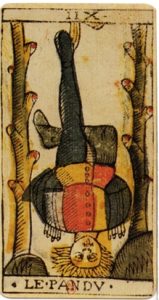A Brief History of Tarot Cards
 By D. J. McAdam
By D. J. McAdam
There are few subjects known to Man about which more misleading or false information has been published than the history of tarot cards. Why?
The answers are simple:
- Tarot cards today are associated with fortune-telling and “the occult.” Serious historians, generally speaking, have no desire to be associated with such subjects.
- The absence of serious inquiries has created a vacuum that has been willingly filled by individuals who approach the subject with something less than scholarly rigor.
- Tarot cards, as a “product of mystery and the unknown,” have been perceived to have benefited by allusions to “a secret past, shrouded in mystery” – at least, by some individuals who have been involved in marketing tarot cards.
- Misinformation about tarot cards has existed for quite some time. Thus, many old (and presumed reliable) works are quoted by newer works, and the misinformation is passed down from one generation to the next.
The purpose of this article is to offer a historically accurate history of tarot cards, to explain how some misinformation about tarot card history came to exist, and to suggest some further avenues for study and research.
In the beginning
Tarot cards are an early form of today’s playing cards, entering Europe in the 14th century in Italy and France. A nice facsimile of one of these early decks, the 15th century Visconti-Sforza Tarocchi Deck, is still available today. They were described by Feliciano Busi as being “from Saracinia,” i.e., the land of the Saracens, or Arabia. It’s important to recall that one of Europe’s greatest civilizations – Moorish Spain – was flourishing at this time, and that there was a great deal of intellectual exchange going on between Europe and the Middle East.
Tarot cards (or taroc cards, or tarocchi cards) were originally used for playing a card game called tarocchi, and had no more (or less) to do with foretelling the future than did other types of playing cards. The major arcana cards did hold secret symbolic meanings for Sufis, who influenced the kabala – this is why correlations are sometimes drawn between the kabala and tarot cards. In card games, the 22 major arcana cards were trump cards, and the 56 minor arcana cards in four suits are similar to today’s standard deck of 52 cards in four suits, with the obvious difference being that the tarot deck has fourteen cards in each suit.
The origin of the word “tarot”
Numerous theories exist, some linking the word with geographic place names, others much more fanciful. Idries Shah, in The Sufis, hypothesizes that tarot is a derivation of the Arab word turuq, which means “four ways.”
And now . . .
Nowadays, most modern tarot cards are used for divination or as a symbol-system for personal growth and development. Tarot cards are often used as vehicles for artistic expression as well, and numerous artists (including Salvador Dali) have used the symbolism of the tarot as a means of creative expression.
How did tarot cards get associated with fortune-telling? Actually, all playing cards have been used for divinatory purposes. Tarot cards, with more intricate designs and an older pedigree than modern decks, tend to look the part more. And, of course, tarot decks were not all that well-known in England – the English having derived their playing card designs from the French – so that when the Order of the Golden Dawn and other British occultists were searching around for things that looked mysterious, tarot cards filled the bill nicely.
Some Common Myths Dispelled
- Tarot cards did not originate in ancient Egypt. This was an invention by an 18th century writer.
- Tarot cards did not arrive in Europe with the Gypsies. This rumor seems to have started because Gypsies were thought to have come from Egypt – which they didn’t – and because Gypsies are often associated with fortune-telling. This myth is easily dispelled, however, when one stops to consider that tarot cards existed in Europe before the arrival of Gypsies.
- Tarot cards have not specifically been known as “cards of the devil.” That title was given to all playing cards by early churchmen – and had nothing to do with fortune-telling. These protectors of the faith were condemning playing cards because they were used for gambling. Some sinners went so far as to play cards when (gasp!) they should have been at church services. There are unconfirmed rumors that this practice may still exist today in some remote places in the world.
Glossary of Terms
- Atouts – French. Alternative term for tarots.
- Attuti – Italian, alternative term for tarots.
- Tarocchi – Italian. Tarot cards, or a game played with tarot cards.
- Tarots – French, tarot cards.
- Trionfi – Italian, alternative term for tarots.
Of Related Interest
- The Suit of Cups
- Tarot In History, by Arthur Edward Waite
Bibliography
- Mollova, Mefküre. “Nouvelle Étymologie du Terme tarock/tarot.” The Playing-Card XXVIII, No. 1 (July/August 1999). In French. Interesting speculation on the etymology of the term “tarot,” also mention of a Turkish manuscript called Codex Cumanicus which is said to have strong links with tarot-related tales.
- Pratesi, F. “The Earliest Tarot Pack Known.” The Playing-Card XVIII (1989) 28-38.
- Shah, Idries. The Sufis. New York, Random House, 1964 and later editions. There is a passing reference to tarot cards in this work which is quite intriguing.
- Tilley, Roger. A History of Playing Cards. New York, Clarkson N. Potter, 1973.